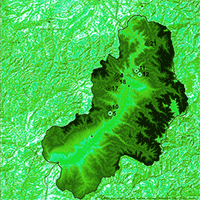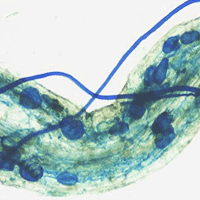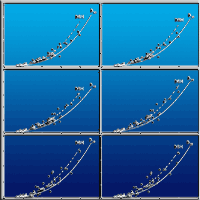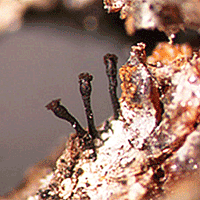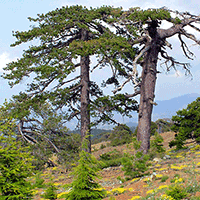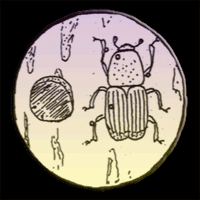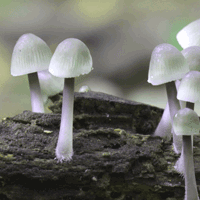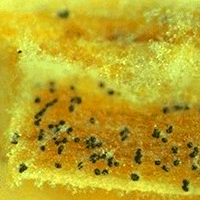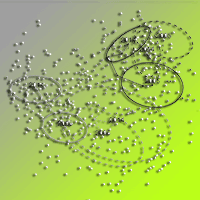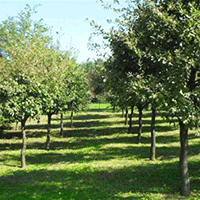
Is Tuber brumale a threat to T. melanosporum and T. aestivum plantations?
Francesca Ori (1), Pamela Leonardi (2), Enrico Stagnini (1), Valentina Balestrini (2), Mirco Iotti (1) , Alessandra Zambonelli (2)
iForest - Biogeosciences and Forestry, Volume 11, Issue 6, Pages 775-780 (2018)
doi: https://doi.org/10.3832/ifor2785-011
Published: Nov 28, 2018 - Copyright © 2018 SISEF
Research Articles
Abstract
True truffles in the genus Tuber are the most valuable ectomycorrhizal fungi and their cultivation has become widespread around the world. Competition with other ectomycorrhizal fungi and especially with undesired Tuber species, like T. brumale, can threaten the success of a truffle plantation. In this work, the competitiveness of T. brumale towards T. melanosporum and T. aestivum was assessed in a 14 year-old plantation carried out planting seedlings inoculated with these three truffle species in adjacent plots. Analyses of both truffle ectomycorrhizas and extra-radical mycelium were carried out in the transects separating the T. brumale plot from T. melanosporum and T. aestivum plots. The results confirm the competitiveness of T. brumale against T. aestivum and T. melanosporum due to its major ability to colonize the soil around its ectomycorrhizas. However, its competitiveness is limited to the transect areas and it was never found inside T. melanosporum plot. These results remark that, in presence of optimal conditions for T. melanosporum and T. aestivum, the greatest risk of contamination with T. brumale is due to wrong greenhouse activity.
Keywords
Competition, Black Truffles, Extra-Radical Mycelium, Ectomycorrhizas, Species-Specific Primers
Authors’ Info
Authors’ address
Enrico Stagnini
Mirco Iotti
Department of Life, Health and Environmental Sciences, University of L’Aquila, I-67100 L’Aquila (Italy)
Valentina Balestrini
Alessandra Zambonelli
Department of Agricultural and Food Sciences, University of Bologna, v.le Fanin 46, I-40127 Bologna (Italy)
Corresponding author
Paper Info
Citation
Ori F, Leonardi P, Stagnini E, Balestrini V, Iotti M, Zambonelli A (2018). Is Tuber brumale a threat to T. melanosporum and T. aestivum plantations?. iForest 11: 775-780. - doi: 10.3832/ifor2785-011
Academic Editor
Alberto Santini
Paper history
Received: Mar 13, 2018
Accepted: Sep 05, 2018
First online: Nov 28, 2018
Publication Date: Dec 31, 2018
Publication Time: 2.80 months
Copyright Information
© SISEF - The Italian Society of Silviculture and Forest Ecology 2018
Open Access
This article is distributed under the terms of the Creative Commons Attribution-Non Commercial 4.0 International (https://creativecommons.org/licenses/by-nc/4.0/), which permits unrestricted use, distribution, and reproduction in any medium, provided you give appropriate credit to the original author(s) and the source, provide a link to the Creative Commons license, and indicate if changes were made.
Web Metrics
Breakdown by View Type
Article Usage
Total Article Views: 44798
(from publication date up to now)
Breakdown by View Type
HTML Page Views: 38233
Abstract Page Views: 2685
PDF Downloads: 3081
Citation/Reference Downloads: 12
XML Downloads: 787
Web Metrics
Days since publication: 2573
Overall contacts: 44798
Avg. contacts per week: 121.88
Citation Metrics
Article Citations
Article citations are based on data periodically collected from the Clarivate Web of Science web site
(last update: Mar 2025)
Total number of cites (since 2018): 7
Average cites per year: 0.88
Publication Metrics
by Dimensions ©
Articles citing this article
List of the papers citing this article based on CrossRef Cited-by.
References
Anatomical characteristics of identified ectomycorrhizas: an attempt towards a natural classification. In: “Mycorrhiza: Structure, Function, Molecular Biology and Biotechnology” (Varma AK, Hock B eds). Springer, Berlin, Germany, pp. 685-734.
Gscholar
Prime osservazioni sulla sostituzione delle micorrize di Tuber nelle tartufaie coltivate [First observations of replacement of Tuber mycorrhizas in cultivated truffle orchards]. In: Proceedings of the “Seminario sullo Stato Attuale della Tartuficoltura Italiana” (Bencivenga M, Donnini D, Gobbini A eds), Spoleto-Norcia (Italy), 21-22 Feb 2004. Associazione “il Tartufo nel 2000”, Gruppo Micologico “Valle Spoletana”, Norcia, Italy, pp. 75-80. [in Italian]
Gscholar
Research results in truffle beds of the Umbria region. In: Proceedings of the “3rd International Conference on Truffles” (Donnini D ed). Spoleto (Italy) 25-28 Nov 2008. Comunità Montana dei Monti Martano, Serano e Subasio, Italy, pp. 577-589. [in Italian]
Gscholar
Analysis of Tuber melanosporum mycorrhizae in an 11-year-old truffle-bed. Micologia e Vegetazione Mediterranea 7: 159-171.
Gscholar
Differentiation among truffle species based on habitat preferences. In: Proceedings of the 5th International Conference “Science et Culture de la Truffe” (Courvoisier M, Olivier JM, Chevalier G eds). Aix-en-Provence (France) 4-6 Mar 1999. Federation Française des Trufficulteurs, Paris, France, pp. 193-195.
Gscholar
Effect of soil conditions on the fruiting of Perigord truffle (Tuber melanosporum). In: Proceedings of the 5th International Conference “Science et Culture de la Truffe” (Courvoisier M, Olivier JM, Chevalier G eds). Aix-en-Provence (France) 4-6 Mar 1999. Federation Française des Trufficulteurs, Paris, France, pp. 257-259.
Gscholar
La truffe de Bourgogne [The Burgundy truffle]. Pétrarque, Levallois-Perret, France, pp. 257. [in French]
Gscholar
Analysis of mycorrhization in over 12 year-old cultivated truffle beds of T. melanosporum Vittad. under various soil and climate conditions. In: Proceedings of the 5th International Conference “Science et Culture de la Truffe” (Courvoisier M, Olivier JM, Chevalier G eds). Aix-en-Provence (France) 4-6 Mar 1999. Federation Française des Trufficulteurs, Paris, France, pp. 437-440.
Gscholar
Competition between some ectomycorrhizal fungi and Tuber melanosporum in a cultivated truffle bed. Micologia e Vegetazione Mediterranea 7: 173-188.
Gscholar
Soil characteristics of Tuber melanosporum habitat. In: “True Truffles (Tuber spp.) in the world” (Zambonelli A, Iotti M, Murat C eds). Soil Biology series, vol. 47, Springer International Publishing, Cham, Switzerland, pp. 169-190.
CrossRef | Gscholar
Truffe et trufficulture [Truffles and trufficulture]. FANLAC, Périgueux, France, pp. 400. [in French]
Gscholar
La truffe. Guide technique de trufficulture [The truffle: technical guide for truffle cultivation]. Centre Technique Interprofessionnel des Fruits et Légumes, Paris, France, pp. 268. [in French]
Gscholar
Truffles d’Europe et de Chine [Truffles of Europe and China]. INRA, Paris, France, pp. 155. [in French]
Gscholar
Mycorrhizal symbiosis (3rd edn). Academic Press, New York, USA, pp. 800.
Gscholar
Pressure of contamination mycorrhizal fungi against black truffle in spontaneous and cultivated truffières in France. In: Abstracts of the “4th International Workshop on Edible Mycorrhizal Mushroom” (Honrubia M, Morte A, Torrente P eds), Murcia (Spain) 28 Nov - 2 Dec 2005. Universidad de Murcia, Spain, pp. 116.
Gscholar
Black truffle cultivation and competing fungi. In: Proceedings of the “7th International Conference on Mushroom Biology and Mushroom Products (Savoie JM, Foulongne-Oriol M, Largeteau M, Barroso G eds), Arcachon (France) 4-7 Oct 2011. INRA, Bordeaux, France, pp. 516-528.
Online | Gscholar
Contamination by Tuber brumale in truffle plantations: observations, experimentations and strategies of cultivation protection; the example of a truffle plantation at Miers in the Lot department, France. In: Proceedings of the 5th International Conference “Science et Culture de la Truffe” (Courvoisier M, Olivier JM, Chevalier G eds), Aix-en-Provence (France) 4-6 Mar 1999. Federation Française des Trufficulteurs, Paris, France, pp. 466-468.
Gscholar
Ecological and genetic advances in the cultivation of Tuber spp. Revista Fitotecnia Mexicana 40: 371-377.
Gscholar

